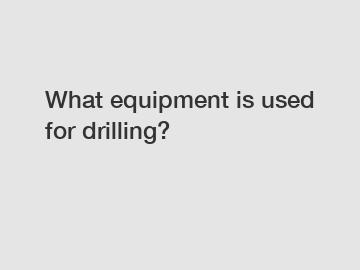What equipment is used for drilling?
Drilling is a fundamental process that has revolutionized numerous industries, enabling us to extract valuable resources from deep within the Earth's crust. Over the years, advancements in technology have led to the development of highly sophisticated drilling equipment, ensuring more efficient and precise operations. In this blog, we will dive into the world of drilling equipment, exploring the cutting-edge tools used in various drilling operations.
1. The Mighty Drill Rig:
Drill rigs are the backbone of any drilling operation, designed to bore through layers of soil, rock, or other materials. These rigs come in various sizes and configurations, catering to specific drilling requirements. One of the most commonly used types is the rotary drilling rig. Equipped with a rotating drill bit, it applies downward pressure, creating boreholes efficiently. Advanced drill rigs with a high degree of automation, computerized controls, and built-in safety features have become the industry standard, ensuring reliable and safe drilling operations.

2. Drilling Bits: Diving into the Details:
Drill bits, the heart of any drilling operation, come in diverse variants suited for different geological formations. For example, roller cone bits are ideal for drilling through soft formations, while fixed cutter bits, including polycrystalline diamond compact (PDC) bits, excel in harder formations. These cutting-edge PDC bits utilize synthetic diamond cutters, providing enhanced durability and faster penetration rates. Furthermore, technologies like hybrid bits combining PDC inserts and roller cones aim to maximize the drilling efficiency even further.
3. Measurement While Drilling (MWD) Systems:
To ensure precision and accuracy in drilling operations, the industry relies heavily on MWD systems. These systems employ various sensors and tools to gather real-time data during drilling, providing valuable insights into the wellbore conditions. MWD systems measure parameters like the inclination, azimuth, and formation properties, facilitating well positioning and aiding in decision-making throughout the drilling process. The integration of MWD technology with rig automation has taken drilling to new heights, reducing non-productive time and enhancing wellbore placement accuracy.
4. Directional Drilling Tools:
In certain applications, drilling straight boreholes may not be sufficient. Directional drilling tools have emerged as an invaluable solution, enabling drilling in multiple directions and angles. These tools include mud motors, surveying instruments, and rotary steerable systems. Mud motors, powered by drilling fluid pressure, impart the necessary rotational force to the drill bit, helping achieve specific well trajectories. Surveying instruments enable continuous monitoring of the borehole's inclination and azimuth, crucial for accurate well placement in complex formations. Rotary steerable systems provide precise control, allowing operators to achieve specific well profiles and optimize reservoir contact.
5. Advanced Drilling Fluids:
Drilling fluids, often called mud, play a crucial role in drilling operations. Beyond their primary function of cooling and lubricating the drill bit, modern drilling fluids incorporate advanced additives for wellbore stability and formation damage control. For instance, synthetic-based muds and oil-based muds excel in extreme conditions, with excellent lubrication properties and resistance to high temperatures. Innovative fluids allow for efficient cuttings removal from the wellbore and minimize the risk of unwanted fluid influx.
6. Casing and Cementing Equipment:
Casing and cementing serve as vital components in creating a secure wellbore. Casing, typically steel pipes, provides structural integrity, preventing well collapse and protecting the environment. Cementing equipment ensures the proper placement of cement between the casing and the formation, sealing off unwanted zones and maintaining well stability. Advanced systems with automated cement mixing, enhanced placement monitoring, and cement quality analysis have significantly improved well integrity and reduced the environmental footprint.
Conclusion:
The drilling industry has witnessed remarkable advancements in equipment, revolutionizing the way we extract resources from within the Earth. From powerful drill rigs and cutting-edge drill bits to advanced MWD systems and directional drilling tools, the diverse arsenal of equipment has transformed drilling operations to be more efficient, accurate, and environmentally responsible. As technology continues to advance, we can look forward to even more innovative solutions that push the boundaries of drilling capabilities, unlocking new frontiers beneath our feet.
Contact us to discuss your requirements of wellhead casing spear machinery exporter, elevator links drilling, wellhead casing spears machinery exporter. Our experienced sales team can help you identify the options that best suit your needs.

Comments